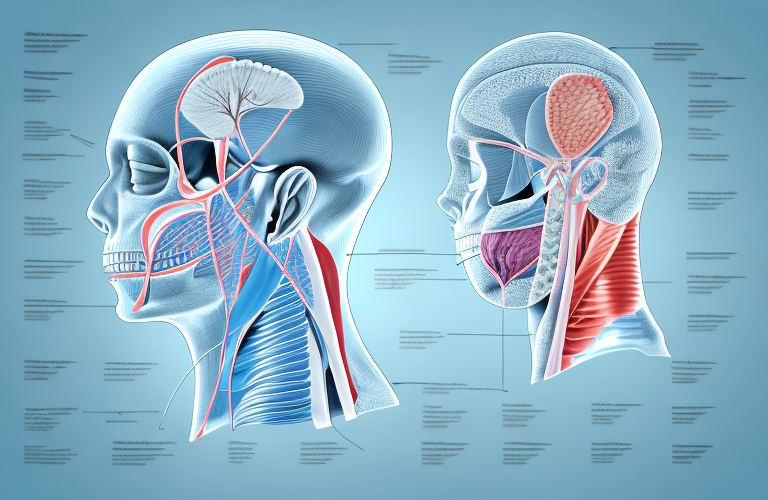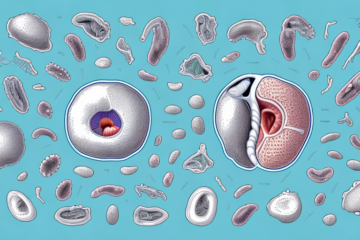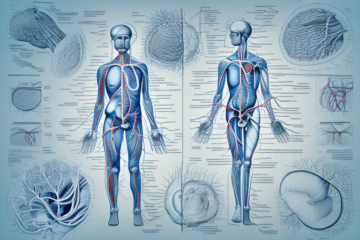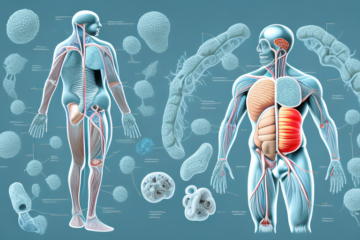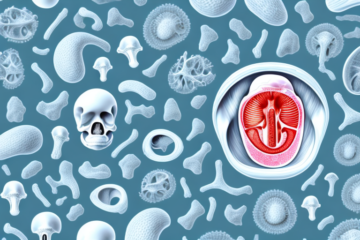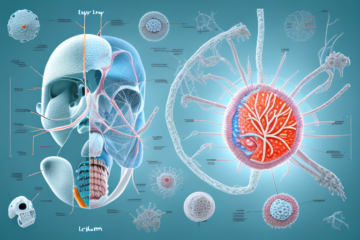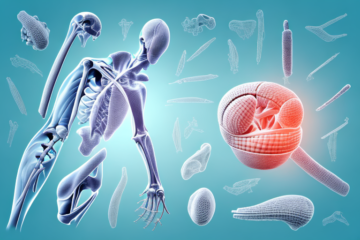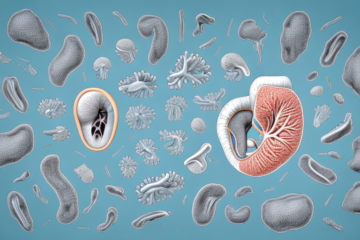The pharynx is an organ that is essential to both the respiratory and digestive systems. It is a muscular tube that connects the nasal cavity, mouth, and larynx to the esophagus and trachea. The pharynx has a complex anatomy that is essential for carrying out various functions, including respiration, swallowing, and speech production. In this article, we will provide an overview of the pharynx, including its anatomy, functions, and disorders.
Understanding the Pharynx: An Overview
The pharynx is a muscular tube that is approximately 12 centimeters long and 4 centimeters in diameter. It is located behind the nasal cavity, mouth, and larynx and extends from the base of the skull to the level of the sixth cervical vertebra. The pharynx is divided into three parts: the nasopharynx, oropharynx, and laryngopharynx. The nasopharynx is located behind the nasal cavity and is responsible for carrying air into the respiratory system. The oropharynx, located behind the mouth, is involved in swallowing and speech production. The laryngopharynx is the lower part of the pharynx and leads to the esophagus and trachea.
The pharynx plays a crucial role in the digestive and respiratory systems. It serves as a passageway for food and liquids to enter the esophagus and stomach, while also allowing air to pass through to the lungs. The muscles in the pharynx contract and relax in a coordinated manner to facilitate these functions.
Disorders of the pharynx can lead to a variety of symptoms, including difficulty swallowing, hoarseness, and breathing problems. Common conditions that affect the pharynx include tonsillitis, pharyngitis, and laryngitis. Treatment options depend on the underlying cause and may include antibiotics, pain relievers, and surgery.
The Anatomy of the Pharynx: A Comprehensive Guide
The pharynx has a complex anatomy that is essential for carrying out various functions. The pharynx is lined with a mucous membrane that contains lymphoid tissue that is involved in immune function. The pharynx also has a series of muscles that contract to move food and air through the organ. The muscles of the pharynx are innervated by the vagus nerve, which is responsible for controlling the pharyngeal muscles, as well as the muscles of the larynx.
In addition to its role in digestion and respiration, the pharynx also plays a crucial role in speech production. The muscles of the pharynx work in conjunction with the tongue, lips, and other structures to produce a wide range of sounds and vocalizations. Damage to the pharynx, such as from a stroke or injury, can result in difficulty speaking or swallowing.
There are several conditions that can affect the pharynx, including pharyngitis (inflammation of the pharynx), tonsillitis (inflammation of the tonsils), and pharyngeal cancer. Treatment for these conditions may include antibiotics, surgery, or radiation therapy, depending on the severity and underlying cause of the condition.
What is the Function of the Pharynx?
The pharynx is an essential organ that plays a vital role in both the respiratory and digestive systems. In the respiratory system, the pharynx carries air from the nasal cavity and mouth to the trachea and lungs. In the digestive system, the pharynx helps to move food from the mouth to the esophagus and stomach. The pharynx also plays a critical role in speech production, as it is involved in the creation of several speech sounds.
Additionally, the pharynx is responsible for filtering and humidifying the air that we breathe in. It contains tiny hairs called cilia that trap dust, pollen, and other particles, preventing them from entering the lungs. The pharynx also moistens the air, which helps to prevent irritation of the respiratory tract.
Furthermore, the pharynx is a crucial part of the immune system. It contains lymphoid tissue, which produces white blood cells that help to fight off infections. The tonsils, which are located in the pharynx, are a part of this lymphoid tissue and play a vital role in protecting the body from harmful pathogens.
The Role of the Pharynx in Respiration
The pharynx is an essential component of the respiratory system. It is responsible for carrying air from the nasal cavity and mouth to the trachea and lungs. When air enters the pharynx, the muscles of the pharynx contract, causing the air to move downward toward the lungs. The pharynx also plays an essential role in filtering and humidifying the air before it reaches the lungs.
In addition to its role in respiration, the pharynx also plays a crucial role in the digestive system. It serves as a passageway for food and liquids to travel from the mouth to the esophagus. The muscles of the pharynx work in coordination with the muscles of the esophagus to move food and liquids down into the stomach. This dual function of the pharynx highlights its importance in maintaining overall health and wellbeing.
How the Pharynx Plays a Key Role in Digestion
The pharynx is also an essential component of the digestive system. When food enters the pharynx, the muscles of the pharynx contract, pushing the food down into the esophagus and stomach. The pharynx also plays a critical role in preventing food and liquids from entering the respiratory system.
In addition to its role in digestion, the pharynx also serves as a pathway for air to travel in and out of the body during breathing. The pharynx is connected to the nasal cavity and the larynx, allowing air to pass through it and into the lungs. This dual function of the pharynx highlights its importance in both the digestive and respiratory systems.
Common Disorders of the Pharynx and How to Treat Them
Like any other organ, the pharynx can be affected by a range of disorders. Some of the most common disorders of the pharynx include tonsillitis, pharyngeal cancer, and dysphagia. Treatment for these disorders can vary depending on the severity of the condition. In some cases, medication or surgery may be necessary to treat the disorder.
Tonsillitis is a common disorder of the pharynx that occurs when the tonsils become inflamed. Symptoms of tonsillitis include sore throat, difficulty swallowing, and fever. Treatment for tonsillitis may include antibiotics, pain relievers, and in severe cases, tonsillectomy.
Pharyngeal cancer is a serious condition that can affect the pharynx. Symptoms of pharyngeal cancer include difficulty swallowing, persistent sore throat, and ear pain. Treatment for pharyngeal cancer may include radiation therapy, chemotherapy, and surgery.
The Connection Between the Pharynx and Ear Infections
The pharynx is also connected to the ears. The Eustachian tubes, which are responsible for equalizing the pressure in the middle ear, connect the nasopharynx to the ear. When the pharynx becomes inflamed, it can cause the Eustachian tubes to become blocked, leading to ear infections.
Ear infections can be quite painful and can cause temporary hearing loss. They are more common in children than in adults because children have shorter and more horizontal Eustachian tubes, which makes it easier for bacteria to travel from the pharynx to the ear. However, adults can also get ear infections, especially if they have a cold or allergies that cause inflammation in the pharynx. It is important to seek medical attention if you suspect you have an ear infection, as untreated infections can lead to more serious complications.
The Importance of Good Oral Health for a Healthy Pharynx
Good oral health is critical for a healthy pharynx. Poor oral hygiene can lead to a buildup of bacteria in the mouth, which can cause inflammation and infections in the pharynx. It is essential to practice good oral hygiene, including brushing your teeth twice a day, flossing, and visiting your dentist regularly.
In addition to practicing good oral hygiene, there are other steps you can take to maintain a healthy pharynx. These include avoiding smoking and excessive alcohol consumption, as both can irritate and damage the pharynx. Additionally, staying hydrated by drinking plenty of water can help keep the pharynx moist and prevent dryness, which can lead to irritation and discomfort. By taking these steps, you can help ensure that your pharynx stays healthy and free from infection.
Tips for Maintaining a Healthy and Functioning Pharynx
There are several steps you can take to maintain a healthy and functioning pharynx. These include avoiding smoking and excessive alcohol consumption, staying hydrated, and eating a healthy and balanced diet. It is also essential to seek medical attention if you experience any symptoms of a pharyngeal disorder.
In addition to these steps, practicing good oral hygiene can also help maintain a healthy pharynx. Brushing your teeth twice a day, flossing regularly, and using mouthwash can help prevent the buildup of harmful bacteria in your mouth and throat. Additionally, avoiding sharing utensils or drinks with others can also reduce your risk of contracting infections that can affect your pharynx.
How to Spot Symptoms of a Pharyngeal Cancer Early On
Pharyngeal cancer is a type of cancer that affects the pharynx. Symptoms of pharyngeal cancer can include difficulty swallowing, a persistent sore throat, and hoarseness. It is important to seek medical attention if you experience any of these symptoms, as early detection can lead to more effective treatment.
Other symptoms of pharyngeal cancer may include ear pain, a lump in the neck, or unexplained weight loss. It is important to note that these symptoms can also be caused by other conditions, but it is always better to err on the side of caution and get checked out by a medical professional. Regular check-ups with your doctor can also help with early detection and prevention of pharyngeal cancer.
The Link Between Smoking and Increased Risk of Pharyngeal Cancer
Smoking is a significant risk factor for pharyngeal cancer. According to the American Cancer Society, people who smoke are six times more likely to develop pharyngeal cancer than non-smokers. It is essential to quit smoking to reduce your risk of developing this condition.
In addition to smoking, other factors can increase the risk of pharyngeal cancer. Heavy alcohol consumption, poor oral hygiene, and a diet low in fruits and vegetables can also contribute to the development of this type of cancer. It is important to maintain good oral hygiene and a healthy diet to reduce your risk.
If you have a family history of pharyngeal cancer, you may be at a higher risk of developing the condition. Regular check-ups with your doctor and screenings can help detect any signs of cancer early on. Early detection can increase the chances of successful treatment and recovery.
Understanding Swallowing Disorders and Their Connection to the Pharynx
Dysphagia is a swallowing disorder that can occur as a result of damage to the pharynx. Symptoms of dysphagia can include difficulty swallowing, choking, and aspiration. Treatment for dysphagia can include exercises to strengthen the pharyngeal muscles, medication, and surgery in severe cases.
The pharynx is a muscular tube that connects the mouth and the esophagus. It plays a crucial role in the swallowing process by helping to move food and liquids from the mouth to the esophagus. When the pharynx is damaged, it can lead to dysphagia and other swallowing disorders.
There are several factors that can cause damage to the pharynx, including neurological disorders, head and neck injuries, and certain medical conditions such as cancer. It is important to seek medical attention if you experience any symptoms of dysphagia, as early diagnosis and treatment can help prevent complications and improve your quality of life.
A Look at How Radiation Therapy Can Impact the Functioning of Your Pharynx
Radiation therapy is a common treatment for pharyngeal cancer. However, radiation therapy can also damage the pharynx, leading to difficulty swallowing and other complications. It is essential to talk to your doctor about the potential side effects of radiation therapy and how they can be managed.
One of the potential side effects of radiation therapy on the pharynx is the development of mucositis. Mucositis is the inflammation and ulceration of the mucous membranes lining the digestive tract. This can cause pain and discomfort, making it difficult to eat and drink. Your doctor may recommend a special diet or prescribe medication to manage the symptoms of mucositis. It is important to follow your doctor’s instructions carefully to ensure the best possible outcome from your radiation therapy treatment.
Surgical Procedures for Treating Disorders of the Pharynx
In some cases, surgery may be necessary to treat disorders of the pharynx. Surgery can be used to remove cancerous tumors, repair damage to the pharynx, or improve swallowing function. Your doctor can determine if surgery is the right treatment option for your condition.
In conclusion, the pharynx is a vital organ that plays a critical role in both the respiratory and digestive systems. It has a complex anatomy and is involved in a range of functions, including respiration, swallowing, and speech production. Understanding the structure and function of the pharynx is essential for maintaining a healthy and functioning organ. If you experience any symptoms related to the pharynx, it is essential to seek medical attention to receive appropriate treatment.
One common surgical procedure for treating disorders of the pharynx is a pharyngectomy, which involves the removal of part or all of the pharynx. This procedure is typically used to treat advanced cases of cancer that have spread to the pharynx. Another surgical option is a pharyngoplasty, which is used to repair defects or damage to the pharynx. This procedure involves the reconstruction of the pharynx using tissue from other parts of the body.
It is important to note that surgery is not always the first line of treatment for disorders of the pharynx. Other treatment options, such as radiation therapy or chemotherapy, may be used depending on the specific condition and its severity. Your doctor will work with you to determine the best course of treatment for your individual needs.

